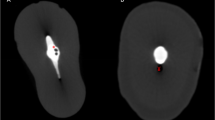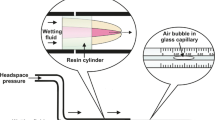Abstract
Objectives
In this in vitro study, we assessed filling characteristics (adaptation, homogeneity, sealer percentage, position of the carrier) of warm and cold obturation methods in curved root canals.
Materials and methods
A reciprocating method was used to prepare 90 curved roots (25 ° average curvature) to an apical size of 25.08. They were then obturated with either (A) Guttafusion (VDW, Munich, Germany), (B) Thermafil (Maillefer, Ballaigues, Switzerland) or (C) single cone technique using 25.08 gutta-percha (VDW) and sealer (2Seal easymix) (n = 30 each group). Five sections in 1-mm steps were obtained from each root, beginning 1 mm short of the apex. The percentage of voids in contact with root canal walls (PVO), the proportion of voids per area (PVA) and the percentage of sealer per area (PSA) were measured.
Results
Little to no differences between Guttafusion and Thermafil were seen in curved root canals with respect to adaptation and homogeneity in the apical region. Both methods showed significantly better adaptation and homogeneity than the single cone technique. The proportion of sealer was significantly greater when roots were obturated with Guttafusion than with Thermafil, but both warm obturation techniques had significantly smaller sealer areas than the single cone technique.
Conclusions
Compared to the single cone technique, a more favourable root canal filling with less sealer could be expected from both warm obturation techniques in curved root canals.
Clinical relevance
The easier-to-handle Guttafusion leads to comparable results as Thermafil in curved root canals.



Similar content being viewed by others

References
Wu MK, Wesselink PR (1993) Endodontic leakage studies reconsidered. Part I. Methodology, application and relevance. Int Endod J 26:37–43
Kontakiotis EG, Wu MK, Wesselink PR (1997) Effect of sealer thickness on long-term sealing ability: a 2-year follow-up study. Int Endod J 30:307–312
Sakaue H, Komatsu K, Yoshioka T, Ishimura H, Ebihara A, Suda H (2013) Evaluation of coronal leakage and pathway of dye leakage after obturation with various materials for open apical foramina. Dent Mater J 32:130–137
Orstavik D, Nordahl I, Tibballs JE (2001) Dimensional change following setting of root canal sealer materials. Dent Mater 17:512–519
Dummer PM, Kelly T, Meghji A, Sheikh I, Vanitchai JT (1993) An in vitro study of the quality of root fillings in teeth obturated by lateral condensation of gutta-percha or Thermafil obturators. Int Endod J 26:99–105
Jarrett IS, Marx D, Covey D, Karmazin M, Lavin M, Gound T (2004) Percentage of canals filled in apical cross sections—an in vitro study of seven obturation techniques. Int Endod J 37:392–398. doi:10.1111/j.1365-2591.2004.00821.x
De-Deus G, Gurgel-Filho ED, Magalhaes KM, Coutinho-Filho T (2006) A laboratory analysis of gutta-percha-filled area obtained using thermafil, system B and lateral condensation. Int Endod J 39:378–383. doi:10.1111/j.1365-2591.2006.01082.x
De-Deus G, Maniglia-Ferreira CM, Gurgel-Filho ED, Paciornik S, Machado AC, Coutinho-Filho T (2007) Comparison of the percentage of gutta-percha-filled area obtained by Thermafil and System B. Aust Endod J 33:55–61. doi:10.1111/j.1747-4477.2007.00047.x
ElAyouti A, Kiefner P, Hecker H, Chu A, Lost C, Weiger R (2009) Homogeneity and adaptation of endodontic fillings in root canals with enlarged apical preparation. Oral Surg Oral Med Oral Pathol Oral Radiol Endod 108:e141–e146. doi:10.1016/j.tripleo.2009.04.022
Peng L, Ye L, Tan H, Zhou X (2007) Outcome of root canal obturation by warm gutta-percha versus cold lateral condensation: a meta-analysis. J Endod 33:106–109. doi:10.1016/j.joen.2006.09.010
Whitworth J (2005) Methods of filling root canals: principles and practices. Endod Topics 33:2–24
Horsted-Bindslev P, Andersen MA, Jensen MF, Nilsson JH, Wenzel A (2007) Quality of molar root canal fillings performed with the lateral compaction and the single-cone technique. J Endod 33:468–471. doi:10.1016/j.joen.2006.12.016
Souza EM, Wu MK, van der Sluis LW, Leonardo RT, Bonetti-Filho I, Wesselink PR (2009) Effect of filling technique and root canal area on the percentage of gutta-percha in laterally compacted root fillings. Int Endod J 42:719–726. doi:10.1111/j.1365-2591.2009.01575.x
Wu MK, Bud MG, Wesselink PR (2009) The quality of single cone and laterally compacted gutta-percha fillings in small and curved root canals as evidenced by bidirectional radiographs and fluid transport measurements. Oral Surg Oral Med Oral Pathol Oral Radiol Endod 108:946–951. doi:10.1016/j.tripleo.2009.07.046
Schafer E, Nelius B, Burklein S (2012) A comparative evaluation of gutta-percha filled areas in curved root canals obturated with different techniques. Clin Oral Investig 16:225–230. doi:10.1007/s00784-011-0509-z
Marciano MA, Ordinola-Zapata R, Cunha TV, Duarte MA, Cavenago BC, Garcia RB, Bramante CM, Bernardineli N, Moraes IG (2011) Analysis of four gutta-percha techniques used to fill mesial root canals of mandibular molars. Int Endod J 44:321–329. doi:10.1111/j.1365-2591.2010.01832.x
Somma F, Cretella G, Carotenuto M, Pecci R, Bedini R, De Biasi M, Angerame D (2011) Quality of thermoplasticized and single point root fillings assessed by micro-computed tomography. Int Endod J 44:362–369. doi:10.1111/j.1365-2591.2010.01840.x
Johnson WB (1978) A new gutta-percha technique. J Endod 4:184–188. doi:10.1016/S0099-2399(78)80173-3
Lares C, elDeeb ME (1990) The sealing ability of the Thermafil obturation technique. J Endod 16:474–479. doi:10.1016/S0099-2399(07)80176-2
Beasley RT, Williamson AE, Justman BC, Qian F (2013) Time required to remove guttacore, thermafil plus, and thermoplasticized gutta-percha from moderately curved root canals with protaper files. J Endod 39:125–128. doi:10.1016/j.joen.2012.10.014
Li GH, Niu LN, Selem LC, Eid AA, Bergeron BE, Chen JH, Pashley DH, Tay FR (2014) Quality of obturation achieved by an endodontic core-carrier system with crosslinked gutta-percha carrier in single-rooted canals. J Dent 42:1124–1134. doi:10.1016/j.jdent.2014.04.008
Leung SF, Gulabivala K (1994) An in-vitro evaluation of the influence of canal curvature on the sealing ability of Thermafil. Int Endod J 27:190–196
Schneider SW (1971) A comparison of canal preparations in straight and curved root canals. Oral Surg Oral Med Oral Pathol 32:271–275
Brunner E, Domhof S, Langer F (2002) Nonparametric analysis of longitudinal data in factorial experiments. Wiley, New York
Gulsahi K, Cehreli ZC, Kuraner T, Dagli FT (2007) Sealer area associated with cold lateral condensation of gutta-percha and warm coated carrier filling systems in canals prepared with various rotary NiTi systems. Int Endod J 40:275–281. doi:10.1111/j.1365-2591.2006.01213.x
Keles A, Ahmetoglu F, Ocak MS, Dayi B, Bozkurt A, Orucoglu H (2014) Comparative analysis of three different filling techniques and the effects of experimental internal resorptive cavities on apical microleakage. Eur J Dent 8:32–37. doi:10.4103/1305-7456.126237
Hayakawa T, Tomita F, Okiji T (2010) Influence of the diameter and taper of root canals on the removal efficiency of thermafil plus plastic carriers using ProTaper retreatment files. J Endod 36:1676–1678. doi:10.1016/j.joen.2010.06.013
Gound TG, Sather JP, Kong TS, Makkawy HA, Marx DB (2009) Graduating dental students’ ability to produce quality root canal fillings using single- or multiple-cone obturation techniques. J Dent Educ 73:696–705
Souza EM, Pappen FG, Shemesh H, Bonanato-Estrela C, Bonetti-Filho I (2009) Reliability of assessing dye penetration along root canal fillings using methylene blue. Aust Endod J 35:158–163. doi:10.1111/j.1747-4477.2009.00161.x
Camps J, Pashley D (2003) Reliability of the dye penetration studies. J Endod 29:592–594. doi:10.1097/00004770-200309000-00012
Rechenberg DK, De-Deus G, Zehnder M (2011) Potential systematic error in laboratory experiments on microbial leakage through filled root canals: review of published articles. Int Endod J 44:183–194. doi:10.1111/j.1365-2591.2010.01821.x
Acknowledgments
The help of Lukas Martig (Institute of Mathematical Statistics and Actuarial Science, University of Bern) with statistics is hereby gratefully acknowledged. The materials used in this study were donated by VDW and Maillefer.
Author information
Authors and Affiliations
Corresponding author
Ethics declarations
Ethical approval
This article does not contain any studies with human participants or animals performed by any of the authors.
Conflict of interest
The authors declare that they have no competing interests.
Rights and permissions
About this article
Cite this article
Neuhaus, K.W., Schick, A. & Lussi, A. Apical filling characteristics of carrier-based techniques vs. single cone technique in curved root canals. Clin Oral Invest 20, 1631–1637 (2016). https://doi.org/10.1007/s00784-015-1674-2
Received:
Accepted:
Published:
Issue Date:
DOI: https://doi.org/10.1007/s00784-015-1674-2



